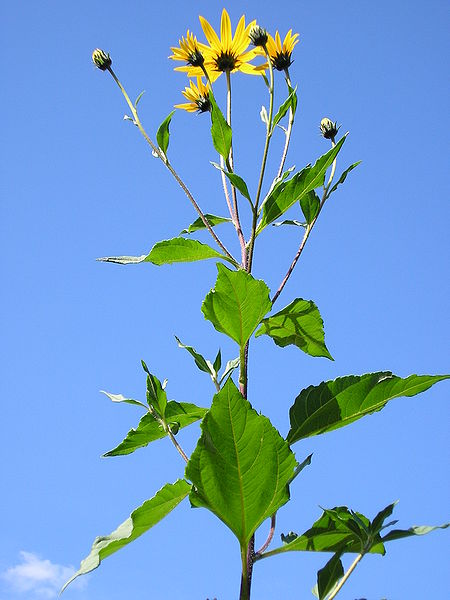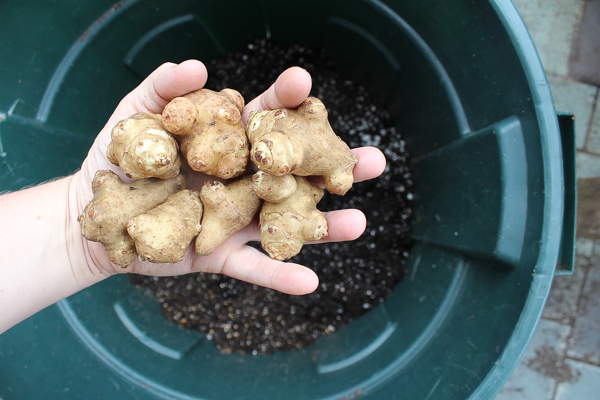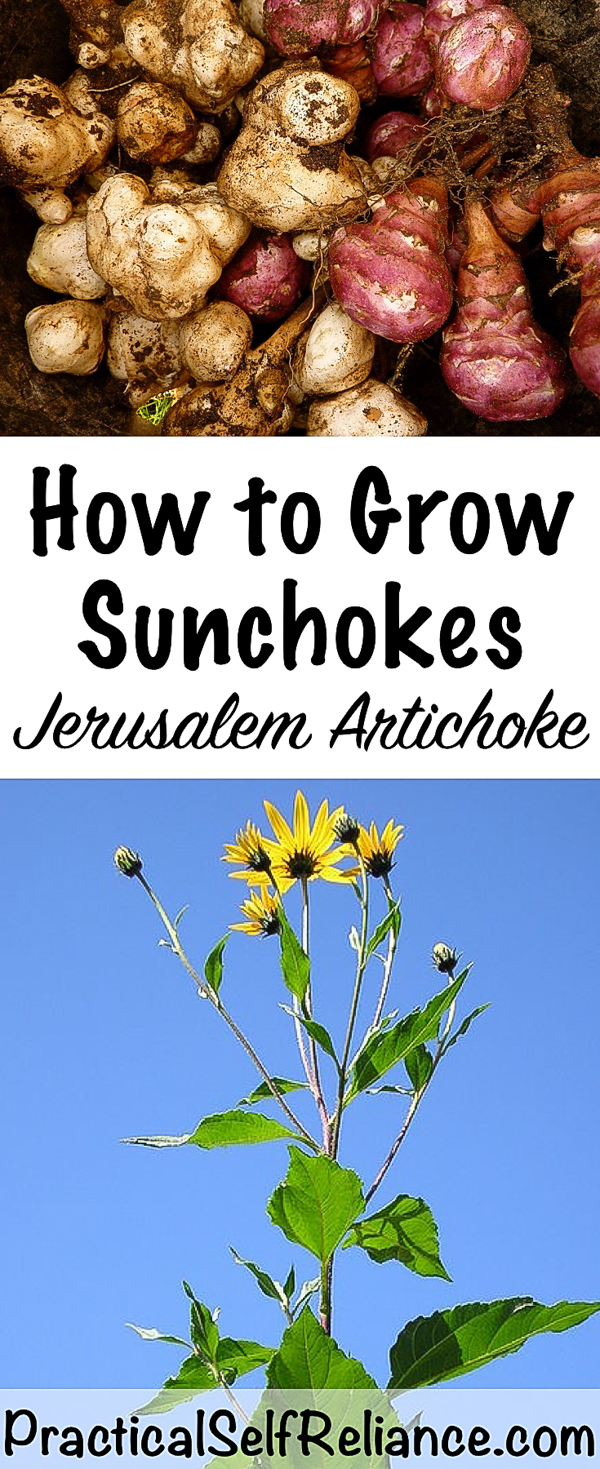Affiliate disclosure: This post may contain affiliate links. Please see our Privacy Policy.
Sunchokes are an amazing survival food, and they’re one of those crops you just can’t kill. That means once you establish a sunchoke patch, it’ll be there forever, which can be a mixed blessing. You’ll always have a source of early spring calories, but be careful where you plant them.

What Are Jerusalem Artichokes?
Jerusalem Artichokes are an edible tuber, much like a potato. They come from a tall plant in the sunflower family, that’s not related to artichokes and has nothing to do with Jerusalem. They’re actually native to the United States, and they can be foraged wild in some parts of the country.
The first time I planted Jerusalem Artichoke I just bought a few tubers at my local coop and planted them at the edge of my garden. Big mistake.
I didn’t know anything about growing sunchokes, and I just assumed they must be something like a potato. Nope. Sunchokes are tall, sunflower-like plants that can grow about 8 feet in the air.
They spread by way of their tasty tubers, which divide beneath the soil. Even one tiny piece of tuber means a new plant the following year, and they’re almost impossible to irradicate.
This can be good if they’re planted far from any other cultivated areas. I like knowing that somewhere in our back 40 there’s a patch of sunchokes that will be growing, proliferating and storing tasty calories in case I ever need it.
If you plant them in your garden, they’ll outcompete and shade out just about everything else, and take over the whole patch in a few years.

Growing Sunchokes
It’s easier to tell you how not to grow sunchokes than how to grow them. They’re a determined perennial, and sunchokes can be pretty invasive.
The only conditions they can’t tolerate are soggy wet soils that rot the tubers. They’re quite drought tolerant, but they do need some water, and they grow best with a regular supply.
They can grow in poor soils, but they’re much easier to harvest in loose soil.
Plant sunchokes either in the fall, from roots harvested that year or in the spring from spring dug roots. The tubers don’t store well, so it’s best to keep them in the ground until you’re ready to either eat them or dig them up to start a new patch. If planting in the spring, wait until soil temperatures warm to at least 50 degrees.
Once established, any tiny piece of root left in the soil will sprout new plants. Try as you might, it’s impossible to harvest every last one, and they’ll be back again the next year. If you do need to get rid of them for some reason, repeated mowing, every week all summer will do it.
To keep them under control, plant them somewhere that you mow around all sides. They spread by root division, and they’ll sneak out of confinement if they get a chance.
I plan to try growing them in a trash can this year just to keep them contained and I’ll let y’all know how it goes.

Where to Buy Sunchokes
If you’re going to grow sunchokes, you’ll need a source of sunchoke tubers. They can often be found at the farmer’s market or your local food co-op, but lacking that, you can just order them online. A single pound of tubers is enough to establish a patch that will last a lifetime.
How to Cook Sunchokes
So now that you have an endless supply of sunchokes, how on earth do you cook them?
They’re a lot like a potato, with more sweetness. They’re sweetest and most flavorful if harvested after a frost in the fall, or in the early spring. Try them roasted, boiled, pureed into a creamy soup or sliced and tossed in olive oil for sunchoke fries.
Sunchokes are loaded with inulin, which is known as a prebiotic. It’s not digestible by humans, but your gut bacteria go nuts for it.
All in all, it’s great for your digestive tract, but if you’re not used to eating prebiotics, your gut bacteria are going to go nuts and give you some pretty intense gas. If it’s your first time eating sunchokes, be careful and try a small portion.





a friend of mine came to me and asked me If i could find. and buy these online ,He had heard about it at church and want to try growing them,so we found them on ebay ,id send a link but they have since sold out. He has a nice patch at the end of the field and the Deer eat the flower buds ,but they keep growing ,his soil type is poor and you see a few thistles growing nearby
Good Morning ! I started mine from seeds planted in an old claw foot bath tub ! They are only small plants this year, but hoping next year, I will get some nice plants and roots ! At least they are contained ! :} Thank You for your insights on growing them !
I love the idea of planting in a claw foot tub.
Would like to know how deep the roots go, and if planting the plants in bags (maybe 2 feet tall or so) would work, and if so how much might be lost in terms of root limitation and lesser soil quality as compared to doing the same thing surrounded by decent soil.
It’s recommended to plant them 4 to 6 ” deep but you want more width than depth so I don’t think they would probably do well in the bags since they won’t have a good area to spread out.
Two problems with your amazon.com link, one being that there are not proper results returned (on the first page anyways), the second that amazon.com is a shitty company, and not just for warehouse workers but also for programmers and managers via serious burnout problems.
Much better to get a proper link to a smaller/better site selling the sunchoke roots (bulbs?) themselves IMO, drive business to a better company and look better in the process.
“irradicate” meansto enroot or fix firmly
“eradicate” means to eliminate, get rid of
I grew a variety of different sunflowers this year, Mammoth, and Indian varietals. Wondering if I can dig up and eat these tubers? Haven’t found anything specific yet on the internet that says whether I can or not. Thanks!
It apparently depends on the variety. I would use the latin name for your particular varieties and search to see if they are edible.
Hi there, nice post! How deep do your sunchokes usually grow? I’m looking at a wide bag potter, 50″ across but only 12″ deep. Will this provide enough depth for them or too shallow? Thanks!
I would definitely give it a try. It is recommended to plant them 4-6″ deep and most sources say that you want more width than depth.
love your site … I am particularly interested in Jeresulem Artichoke … winter now so will try to remember to get next year. Going to take your advice and plant in a more shallow container. I have some round ones with rope handles that are about 2′ deep.
how did the trashcan experiment go?
Really well! They grow great in trash cans. Honestly though, they only rooted in a shallow way, and next time I’m going to use storage totes instead of a deep trash can. More surface area and less depth that’s not used.
Do the deer eat the plants
Ours don’t? But they have plenty of other options here.
They ate mine like crazy until I fenced them in
Found my way here through a series of clicks as I surfed the net this morning. I read that you were going to try growing sunchokes in a trashcan. How did that turn out?
Just fine, they grow well most anywhere provided sun and ample moisture.
I planted a pound last fall. So far not any sign of them this year. We had a lot of rain here in east central Mississippi this spring. Is it possible they all rotted?
It is possible. The only ones I ever had die was because of a very soggy fall/winter/spring. I planted them in the fall, but they were in a low spot and they just didn’t come up in the spring. Lots of water when they’re very young is the only thing that’s killed them for us. They’ll take floods just fine once established.
Now you have me curious to try them. I will definitely check them out. Thanks!